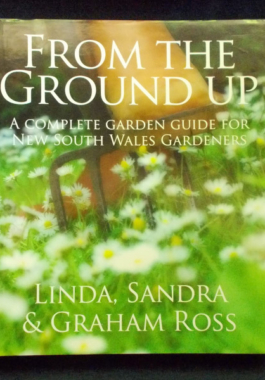-
 When 65-year-old Francis Chichester set sail on his solitary,eastward journey around the world in 1966,many believed he wouldn't return alive. But when the old man returned in his 53-foot ketch Gypsy Moth IV nine months later, he had made history's fastest circumnavigation. Gipsy Moth Circles The World was an international best-seller when it appeared in 1967. It inspired the first solo around-the-world race and remains a timeless testament to the spirit of adventure. With black and white photos.
When 65-year-old Francis Chichester set sail on his solitary,eastward journey around the world in 1966,many believed he wouldn't return alive. But when the old man returned in his 53-foot ketch Gypsy Moth IV nine months later, he had made history's fastest circumnavigation. Gipsy Moth Circles The World was an international best-seller when it appeared in 1967. It inspired the first solo around-the-world race and remains a timeless testament to the spirit of adventure. With black and white photos. -
 As the partner of Fred Astaire, Ginger danced her way into the hearts of film-goers world wide, starring in classics such as Top Hat, Flying Down To Rio, Swing Time and The Barkleys Of Broadway. Yet she more than proved her talent as a dramatic actress in Kitty Foyle, Tender Comrade and Roxie Hart (later filmed as Chicago); as a top comedian in Weekend At The Waldorf and Tales Of Manhattan and onward, to heavy roles in film noire like Storm Warning. This is Ginger's story, told by her - the legendary Astaire Rogers partnership, her five marriages and anecdotes of her co-stars: Jimmy Stewart, Cary Grant, Henry Fonda and Katharine Hepburn among them. A glittering portrait oif a much loved actress and of a now-vanished, glittering Hollywood era. With black and white photographs.
As the partner of Fred Astaire, Ginger danced her way into the hearts of film-goers world wide, starring in classics such as Top Hat, Flying Down To Rio, Swing Time and The Barkleys Of Broadway. Yet she more than proved her talent as a dramatic actress in Kitty Foyle, Tender Comrade and Roxie Hart (later filmed as Chicago); as a top comedian in Weekend At The Waldorf and Tales Of Manhattan and onward, to heavy roles in film noire like Storm Warning. This is Ginger's story, told by her - the legendary Astaire Rogers partnership, her five marriages and anecdotes of her co-stars: Jimmy Stewart, Cary Grant, Henry Fonda and Katharine Hepburn among them. A glittering portrait oif a much loved actress and of a now-vanished, glittering Hollywood era. With black and white photographs. -
 Mature visitors to our shelves may remember the British 70s sitcom The Good Life, wherein Tom and Barbara Good got off the corporate treadmill and began a life of self-sufficiency in Surbiton, complete with pigs, chickens and an irascible goat called Geraldine - much to the initial dismay of their neighbours Margo and Jerry. Their mistakes and adventures were many and hilarious but always on an upward learning curve. Here, Sue Perkins and Giles Coren (Supersizers Go... series) live the good life as an experiment of modern day self sufficiency and have a go at growing and cooking veggies; pottery; baking bread; building a chook run; generating power; how to choose and keep a pig; making Christmas decorations and keeping bees - all a la Tom and Barbara. There's recipes, herbal remedies and how-tos in plenty with coloured photographs.
Mature visitors to our shelves may remember the British 70s sitcom The Good Life, wherein Tom and Barbara Good got off the corporate treadmill and began a life of self-sufficiency in Surbiton, complete with pigs, chickens and an irascible goat called Geraldine - much to the initial dismay of their neighbours Margo and Jerry. Their mistakes and adventures were many and hilarious but always on an upward learning curve. Here, Sue Perkins and Giles Coren (Supersizers Go... series) live the good life as an experiment of modern day self sufficiency and have a go at growing and cooking veggies; pottery; baking bread; building a chook run; generating power; how to choose and keep a pig; making Christmas decorations and keeping bees - all a la Tom and Barbara. There's recipes, herbal remedies and how-tos in plenty with coloured photographs. -
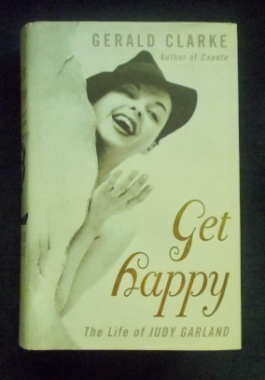 The girl with the pigtails, the symbol of innocence in The Wizard Of Oz; the brightest star of the Hollywood musical and an entertainer of almost magical power; the woman of half a dozen comebacks, a hundred heartbreaks and thousands of headlines. A remarkable list of sources have been drawn on, including the unopened papers discovered in a Tennessee courthouse and the unpublished memoir of Judy's make-up girl and closest confidante as well as Judy's unfinished autobiography. Unforgettable characters are brought to life: Oscar Levant; Orson Welles; Rita Hayworth; Vincente Minelli and the smooth, seductive David Begelmnan, who stole Judy's heart so he could steal her money. Judy described her unfinished autobiography as, '...one hell of a great, everlastingly great book, with humour, tears, fun, emotion and love.' She might just as well have been describing Get Happy. Illustrated with black and white photographs.
The girl with the pigtails, the symbol of innocence in The Wizard Of Oz; the brightest star of the Hollywood musical and an entertainer of almost magical power; the woman of half a dozen comebacks, a hundred heartbreaks and thousands of headlines. A remarkable list of sources have been drawn on, including the unopened papers discovered in a Tennessee courthouse and the unpublished memoir of Judy's make-up girl and closest confidante as well as Judy's unfinished autobiography. Unforgettable characters are brought to life: Oscar Levant; Orson Welles; Rita Hayworth; Vincente Minelli and the smooth, seductive David Begelmnan, who stole Judy's heart so he could steal her money. Judy described her unfinished autobiography as, '...one hell of a great, everlastingly great book, with humour, tears, fun, emotion and love.' She might just as well have been describing Get Happy. Illustrated with black and white photographs. -
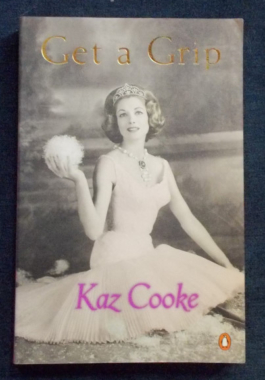
Get A Grip: Kaz Cooke
$9.00Kaz Cooke's observations are timeless, timely reflections on almost everything important, including NASA, interior design pornography, collective nouns, lerv, weirdos and how to find your inner Nanna. She has a weakness for Scottish accents, an undying hatred of cats, a devastating gift for one-liners and an obsession with the Miss Universe contest (because, as its name suggests, people from other planets may enter...). Fierce, funny, frank, intelligent and informative reading; an essential companion to life in the nineties (and may even explain the nineties!) and everything you need to know about thigh boots, political correctness, food fads, foreign policy and the sex life of clams. Cooke started as a cadet journalist at The Age in 1981, a month after her 18th birthday, later ceoming editor of the Age's Friday 'Entertainment Guide' section. Her articles appeared in the 1980s in Dolly, The Australian Women’s Weekly and Cleo. She also wrote an etiquette column for The Age as well as numerous hilarious books about modern life. -

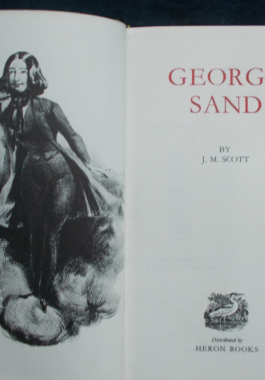
George Sand: J.M. Scott
$15.00George Sand - born Amantine Lucile Aurore Dupin (1804 –1876) - was a French novelist, memoirist and Socialist. One of the most popular writers in Europe in her lifetime, being more renowned than both Victor Hugo and Honoré de Balzac in England in the 1830s and 1840s and recognised as one of the most notable writers of the European Romantic era. She had numerous affairs with luminaries of art and literature and was one of many notable 19th-century women who chose to wear male attire in public. In 1800, the police issued an order requiring women to apply for a permit in order to wear male clothing. Some women applied for health, occupational, or recreational reasons but Sand, a rebel with a cause, was one who wore men's clothing without a permit because they were less expensive and far sturdier than the typical dress of a noblewoman at the time and was one of the first women to smoke cigars publicly. With colour and black and white illustrations. -
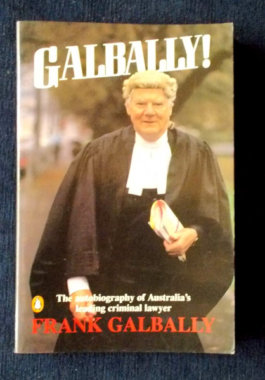
Galbally! Frank Galbally
$9.00Frank Galbally CBE (1922 - 2005) dominated Australian Law for over four decades, frequently at the centre of controversy and always at the heart of things. He represented everyone from painters and dockers to a talking cockatoo; had audiences with popes and took on the Greek Colonels and was embroiled in the politics of 1975 and the policies of Collingwood Football Club. The Krope trial, the Costigan Commission, Kevin Barlow's appeal...the number of legal trials in which Galbally was involved extraordinary and the names became household words. This autobiography contains some of his most famous cases, with a few fighting words regarding crucial aspects of Australian public affairs such as police corruption and the royal commission into crime. Illustrated with black and white photographs. -

 The second and concluding volume of Noël Coward's legendary autobiography. With his trademark wit, he delivers anecdotes about his travels in South America, Hollywood encounters with an array of glamorous stars and directors and details his later theatrical successes, including the Broadway triumph of Design For Living. The showbiz glamour aside, this is a portrait of a middle-aged man coming to terms with a world in disarray; his confused feelings towards the war and his own part in it exposing a more serious and thoughtful side to a performer and raconteur more usually associated with frivolity. Illustrated with black and white photographs.
The second and concluding volume of Noël Coward's legendary autobiography. With his trademark wit, he delivers anecdotes about his travels in South America, Hollywood encounters with an array of glamorous stars and directors and details his later theatrical successes, including the Broadway triumph of Design For Living. The showbiz glamour aside, this is a portrait of a middle-aged man coming to terms with a world in disarray; his confused feelings towards the war and his own part in it exposing a more serious and thoughtful side to a performer and raconteur more usually associated with frivolity. Illustrated with black and white photographs. -

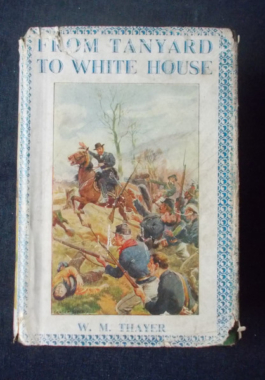 Thayer's biography traces the life of Ulysses S. Grant from birth, to failed businessman; to hero of the Union in the Civil War; to two terms of President of the United States. In the 19th century, one of the surest ways to rise to prominence in American society was to be a war hero, like Andrew Jackson and William Henry Harrison. But few would have predicted such a destiny for Hiram Ulysses Grant. Recently republished as From Tannery To White House.
Thayer's biography traces the life of Ulysses S. Grant from birth, to failed businessman; to hero of the Union in the Civil War; to two terms of President of the United States. In the 19th century, one of the surest ways to rise to prominence in American society was to be a war hero, like Andrew Jackson and William Henry Harrison. But few would have predicted such a destiny for Hiram Ulysses Grant. Recently republished as From Tannery To White House. -
 A short history of literature, art, music, theatre, architecture, science and learning in Australia 1788 - 1972. Dr. Serle discusses the problem of national-versus-international-oriented art and provides an overall theory of the evolution of settler culture and cultural growth in Australia. Australia did lag behind the European and American cultural development before developing its own distinctive characteristics and for decades our culture was a little of this, some of that and a dash of the other, with the few writers and artists scattered in a big country and often unknown to each other. But World War II brought the beginning of institutions that began to nurture culture: the ABC, the Commonwealth Literary Fund, the state education system, the CSIRO, the literary magazines (particularly Meanjin, Southerly and Overland), and to some extent the universities. By the 70s, we were very Australian and original in the creative arts.
A short history of literature, art, music, theatre, architecture, science and learning in Australia 1788 - 1972. Dr. Serle discusses the problem of national-versus-international-oriented art and provides an overall theory of the evolution of settler culture and cultural growth in Australia. Australia did lag behind the European and American cultural development before developing its own distinctive characteristics and for decades our culture was a little of this, some of that and a dash of the other, with the few writers and artists scattered in a big country and often unknown to each other. But World War II brought the beginning of institutions that began to nurture culture: the ABC, the Commonwealth Literary Fund, the state education system, the CSIRO, the literary magazines (particularly Meanjin, Southerly and Overland), and to some extent the universities. By the 70s, we were very Australian and original in the creative arts. -
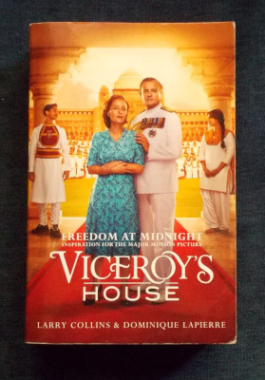 At midnight on 14 August 1947, the Union Jack began its final journey down the flagstaff of Viceroy's House, New Delhi. A fifth of humanity claimed their independence from the greatest empire in history - but the price of freedom was high, as a nation erupted into riots and bloodshed, partition and war. This acclaimed account of the dying days of the British Raj and the drama played out between Lord and Lady Mountbatten, Mahatma Gandhi, Nehru and Jinnah inspired the major film The Viceroy's House. Illustrated with black and white archival photographs.
At midnight on 14 August 1947, the Union Jack began its final journey down the flagstaff of Viceroy's House, New Delhi. A fifth of humanity claimed their independence from the greatest empire in history - but the price of freedom was high, as a nation erupted into riots and bloodshed, partition and war. This acclaimed account of the dying days of the British Raj and the drama played out between Lord and Lady Mountbatten, Mahatma Gandhi, Nehru and Jinnah inspired the major film The Viceroy's House. Illustrated with black and white archival photographs. -
 It seems as if Frank Clune enjoyed writing this book. given how his personality and enthusiasm shows through. He invites his readers to participate as he rambles from Brisbane to Cloncurry, to the Gulf round Cape York and down the east coast. He works his passage over one part of the journey, at others travels as a tourist, and then with his wife. He makes every town he visits special as Clune had a great eye for purple patches or for those slender news items that can be interesting when presented properly. There are cattle duffers, gold discoverers, explorers, convicts, squatters and heads of industry, all sketched colourfully. He dips into history for wrecks, old sea navigators and explorers. Wherever he is, he presents it with his own brand of rare humor. With black and white photographs.
It seems as if Frank Clune enjoyed writing this book. given how his personality and enthusiasm shows through. He invites his readers to participate as he rambles from Brisbane to Cloncurry, to the Gulf round Cape York and down the east coast. He works his passage over one part of the journey, at others travels as a tourist, and then with his wife. He makes every town he visits special as Clune had a great eye for purple patches or for those slender news items that can be interesting when presented properly. There are cattle duffers, gold discoverers, explorers, convicts, squatters and heads of industry, all sketched colourfully. He dips into history for wrecks, old sea navigators and explorers. Wherever he is, he presents it with his own brand of rare humor. With black and white photographs. -
 Fred Hollows (1923 - 1993, AC) was no saint. He didn't pretend to be. He was as rough a diamond as they come. Author Tom Keneally called him 'the wild colonial boy of Australian surgery'. 'Every eye is an eye,' said Fred - and when 3.5 million Africans go blind each year, then the world was not up to scratch for Fred Hollows. Four out of five people who are blind don't need to be - but millions of people are blind simply because they don't have access to treatment. It was daunting, and that was no excuse for inaction or failure. Fred knew what tools were needed. Energy, money, training and a plastic lens factory. Action. So he got busy. He travelled rough roads, operated in a cave, held clinics in dry creek beds and the MiG jets overhead didn't help matters either. When chance took him to Watti Creek and he discovered how bad eye problems were among the outback Aboriginals, he got stuck in. Two years and a quarter of a million kilometres later, the Trachoma Program had fixed the worst of the problem. When Fred got busy, conflict was inevitable, some sensibilities were probably bruised, hindrances were there to overcome, waffle got dismissed and wasted time was not tolerated. But the patient - whoever and wherever he or she might have been, would see the doctor. Today, The Foundation bearing Fred Hollows' name is continuing his dream to end avoidable blindness. Illustrated with black and white photographs.
Fred Hollows (1923 - 1993, AC) was no saint. He didn't pretend to be. He was as rough a diamond as they come. Author Tom Keneally called him 'the wild colonial boy of Australian surgery'. 'Every eye is an eye,' said Fred - and when 3.5 million Africans go blind each year, then the world was not up to scratch for Fred Hollows. Four out of five people who are blind don't need to be - but millions of people are blind simply because they don't have access to treatment. It was daunting, and that was no excuse for inaction or failure. Fred knew what tools were needed. Energy, money, training and a plastic lens factory. Action. So he got busy. He travelled rough roads, operated in a cave, held clinics in dry creek beds and the MiG jets overhead didn't help matters either. When chance took him to Watti Creek and he discovered how bad eye problems were among the outback Aboriginals, he got stuck in. Two years and a quarter of a million kilometres later, the Trachoma Program had fixed the worst of the problem. When Fred got busy, conflict was inevitable, some sensibilities were probably bruised, hindrances were there to overcome, waffle got dismissed and wasted time was not tolerated. But the patient - whoever and wherever he or she might have been, would see the doctor. Today, The Foundation bearing Fred Hollows' name is continuing his dream to end avoidable blindness. Illustrated with black and white photographs. -
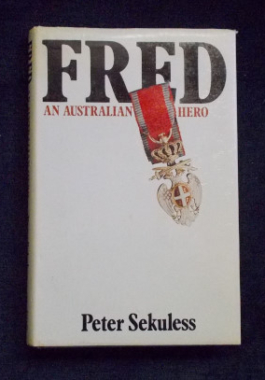 Toward the end of 1977, articles appeared in Australian newspapers about a remarkable 97 year-old Australian who had just died in Khartoum. They told of an heroic figure who had been with General Freyberg, then a junior officer, when he made his daring Dardenelles swim before the landing at Gallipoli; who had been mentioned in dispatches at the Battle of Beersheba; who had been with Lawrence of Arabia and who had won several decorations, including the George Cross for bravery under fire when he was chauffeur to the Governor-General of the Sudan at the time of his assassination in Cairo in 1924. He was one of the few Australians ever to win the coveted Serbian Eagle. This incredible Australian was Frederick Hamilton March. The newspaper articles so intrigued Sekuless than he began keeping a file on Fred March. Eventually, he travelled to Khartoum, Cairo, Gallipoli and London in a quest for information about this elusive and unknown Aussie hero to piece together the fascinating story of Fred March. Illustrated with black and white archival photographs.
Toward the end of 1977, articles appeared in Australian newspapers about a remarkable 97 year-old Australian who had just died in Khartoum. They told of an heroic figure who had been with General Freyberg, then a junior officer, when he made his daring Dardenelles swim before the landing at Gallipoli; who had been mentioned in dispatches at the Battle of Beersheba; who had been with Lawrence of Arabia and who had won several decorations, including the George Cross for bravery under fire when he was chauffeur to the Governor-General of the Sudan at the time of his assassination in Cairo in 1924. He was one of the few Australians ever to win the coveted Serbian Eagle. This incredible Australian was Frederick Hamilton March. The newspaper articles so intrigued Sekuless than he began keeping a file on Fred March. Eventually, he travelled to Khartoum, Cairo, Gallipoli and London in a quest for information about this elusive and unknown Aussie hero to piece together the fascinating story of Fred March. Illustrated with black and white archival photographs. -
 The Fowler Vacola Jar method of preserving fruit and vegetables out of season was world famous and it looks to be coming back into fashion as more and more people grow their own food. Contains very detailed instructions and is a must for those wishing to live the alternative, slower-paced lifestyle.
The Fowler Vacola Jar method of preserving fruit and vegetables out of season was world famous and it looks to be coming back into fashion as more and more people grow their own food. Contains very detailed instructions and is a must for those wishing to live the alternative, slower-paced lifestyle. -
 Once it was the wandering 'swaggie' tramping the bush tracks, who learnt the most about the unusual places and people of Australia. Now it's done in a specially equipped vehicle by Jeff Carter and his wife, who are on the lookout for the off-beat characters, incidents and features. He met the late Sir Donald Campbell, streaking across the Lake Eyre in the Bluebird and Charley King, travelling the outback in a tiny caravan pulled by a donkey team. They saw cattle musters, opal gouging, charcoal burning, limpet-eating star fish and man-eating leeches. They travelled from the mountains of the south to the deserts of the north and everywhere saw something new and strange. Illustrated with many black and white photographs.
Once it was the wandering 'swaggie' tramping the bush tracks, who learnt the most about the unusual places and people of Australia. Now it's done in a specially equipped vehicle by Jeff Carter and his wife, who are on the lookout for the off-beat characters, incidents and features. He met the late Sir Donald Campbell, streaking across the Lake Eyre in the Bluebird and Charley King, travelling the outback in a tiny caravan pulled by a donkey team. They saw cattle musters, opal gouging, charcoal burning, limpet-eating star fish and man-eating leeches. They travelled from the mountains of the south to the deserts of the north and everywhere saw something new and strange. Illustrated with many black and white photographs. -

 The biography of Arthur Upfield, creator of the famous 'Bony' detective stories. Here is Upfield's own story, the author of those remarkable murder mysteries set in odd corners of Australia and featuring the Aboriginal sleuth named 'Bony' - a detailed 'dossier' compiled with the cheerful candour of the subject himself. An Englishman by birth, Arthur Upfield tried his luck in Australia. After a short spell as a waiter in Adelaide, Upfield felt drawn towards the Interior where he became a boundary-rider, offside-driver, cattle-drover, opal-gouger, rabbit-trapper, vermin fence patroller and manager of a camel station, drifting through the strange terrains and unusual company which were later to become the subject of his novels. He also tells how he unwittingly provided a real outback murderer with a 'fool-proof' method of disposing of a body, and who was the original on whom the character of 'Bony' was based. With a forward by 'Detective Inspector Napoleon Bonaparte'. Illustrated with black and white photographs.
The biography of Arthur Upfield, creator of the famous 'Bony' detective stories. Here is Upfield's own story, the author of those remarkable murder mysteries set in odd corners of Australia and featuring the Aboriginal sleuth named 'Bony' - a detailed 'dossier' compiled with the cheerful candour of the subject himself. An Englishman by birth, Arthur Upfield tried his luck in Australia. After a short spell as a waiter in Adelaide, Upfield felt drawn towards the Interior where he became a boundary-rider, offside-driver, cattle-drover, opal-gouger, rabbit-trapper, vermin fence patroller and manager of a camel station, drifting through the strange terrains and unusual company which were later to become the subject of his novels. He also tells how he unwittingly provided a real outback murderer with a 'fool-proof' method of disposing of a body, and who was the original on whom the character of 'Bony' was based. With a forward by 'Detective Inspector Napoleon Bonaparte'. Illustrated with black and white photographs. -

 The true story of the man who pioneered the Flying Doctors and Bush Hospitals of Australia in the early 1900's. Ever the dreamer, Flynn did not rest until his dream of saving lives in the bush was realised through a revolutionary new system of using light aeroplanes as ambulances to help overcome the problems of distance in the huge Australian Outback. With black and white photographs.
The true story of the man who pioneered the Flying Doctors and Bush Hospitals of Australia in the early 1900's. Ever the dreamer, Flynn did not rest until his dream of saving lives in the bush was realised through a revolutionary new system of using light aeroplanes as ambulances to help overcome the problems of distance in the huge Australian Outback. With black and white photographs. -
 As the 1940s came to a close, the dream factory of Hollywood was in turmoil: McCarthyism was a dark shadow, television had begun to make inroads and there was the realism of post-war society. But five young actors came west: James Dean; Rock Hudson; Montgomery Clift; Elizabeth Taylor and Natalie Wood. They became the idols of their generation. As well as their stories, this book encapsulates the glamour, the hype, the delusions and scandals that was the Hollywood of the Fifties. With black and white photographs.
As the 1940s came to a close, the dream factory of Hollywood was in turmoil: McCarthyism was a dark shadow, television had begun to make inroads and there was the realism of post-war society. But five young actors came west: James Dean; Rock Hudson; Montgomery Clift; Elizabeth Taylor and Natalie Wood. They became the idols of their generation. As well as their stories, this book encapsulates the glamour, the hype, the delusions and scandals that was the Hollywood of the Fifties. With black and white photographs. -
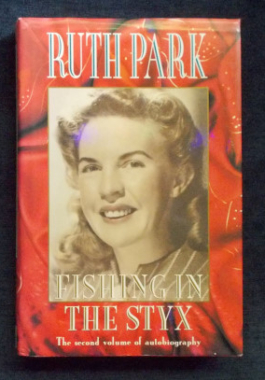 Born in New Zealand, Ruth Park came to Australia to continue her work as a journalist, newly married to D'Arcy Niland. Determined to earn their living as writers, they submitted story outlines to radio stations, idea for articles to newspapers and accepted whatever freelance jobs came their way. The Harp in the South, Park’s first novel, was published in 1948 and set her on the path to becoming one of Australia’s most loved authors. Fishing in the Styx is the second part of her autobiography and is the portrait of a partnership, in life and in work, between two talented, volatile people. Ruth Park’s life is rich in experience and achievement, and her work has given pleasure to generations of readers. Illustrated. https://cosmiccauldronbooks.com.au/p/fence-around-cuckoo-ruth-park/
Born in New Zealand, Ruth Park came to Australia to continue her work as a journalist, newly married to D'Arcy Niland. Determined to earn their living as writers, they submitted story outlines to radio stations, idea for articles to newspapers and accepted whatever freelance jobs came their way. The Harp in the South, Park’s first novel, was published in 1948 and set her on the path to becoming one of Australia’s most loved authors. Fishing in the Styx is the second part of her autobiography and is the portrait of a partnership, in life and in work, between two talented, volatile people. Ruth Park’s life is rich in experience and achievement, and her work has given pleasure to generations of readers. Illustrated. https://cosmiccauldronbooks.com.au/p/fence-around-cuckoo-ruth-park/ -

 A real gem for a sports or bowls fanatic - a celebration of this historical sporting event that Australia was the first nation to host. This volume contains photographs of the Championship Executive Committee, the Organising Committee, articles on the Leagues Bowling Club at Kyeemagh, the game of bowls, ladies' bowling, David Bryant, Neil Benjamin, how bowls became a business, conditions of play and of course - individual photographs of the team members who competed: Australia, Canada, England, Fiji, Hong Kong, Ireland, Jersey, Kenya, Malawi, New Zealand, Papua-New Guinea, Rhodesia,Scotland, South Africa,United States and Wales. There is a daily programme featured and this copy includes a stapled-in alternate programme and a pass card; AND this copy also contains numerous autographs. On a loose slip: David Bryant (World Champion) and Harry Reston 'Scottish Skip' (Scotland); Australia: autographs of Geoff Kelly (Captain) and Peter Rheuben (acquired later since he did not compete in '66); England: autographs of Robbie Stenhouse, Derek 'Mick' Cooper, David Bryant, Tom Brown and John L. Coles (England Bowling Association, replacing William H. Lewis, President, English Bowling Association); Ireland: Cecil Beck and Charlie Taylor; New Zealand: George Boulton, N.Z. Bowling Association President, Norman Lash, Gordon Jolly, Phil Skoglund; Papua-New Guinea: Eric Carburn, Allan Ramsbocham, Barry Welsh, Wally Jackson, Jack Spears; Rhodesia: W.J.R. 'Bill' Jackson; South Africa: Thomas Crossan Press. Numerous photographs.
A real gem for a sports or bowls fanatic - a celebration of this historical sporting event that Australia was the first nation to host. This volume contains photographs of the Championship Executive Committee, the Organising Committee, articles on the Leagues Bowling Club at Kyeemagh, the game of bowls, ladies' bowling, David Bryant, Neil Benjamin, how bowls became a business, conditions of play and of course - individual photographs of the team members who competed: Australia, Canada, England, Fiji, Hong Kong, Ireland, Jersey, Kenya, Malawi, New Zealand, Papua-New Guinea, Rhodesia,Scotland, South Africa,United States and Wales. There is a daily programme featured and this copy includes a stapled-in alternate programme and a pass card; AND this copy also contains numerous autographs. On a loose slip: David Bryant (World Champion) and Harry Reston 'Scottish Skip' (Scotland); Australia: autographs of Geoff Kelly (Captain) and Peter Rheuben (acquired later since he did not compete in '66); England: autographs of Robbie Stenhouse, Derek 'Mick' Cooper, David Bryant, Tom Brown and John L. Coles (England Bowling Association, replacing William H. Lewis, President, English Bowling Association); Ireland: Cecil Beck and Charlie Taylor; New Zealand: George Boulton, N.Z. Bowling Association President, Norman Lash, Gordon Jolly, Phil Skoglund; Papua-New Guinea: Eric Carburn, Allan Ramsbocham, Barry Welsh, Wally Jackson, Jack Spears; Rhodesia: W.J.R. 'Bill' Jackson; South Africa: Thomas Crossan Press. Numerous photographs. -
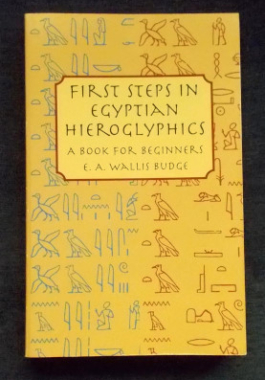 The dearth of suitable introductory texts presents a serious obstacle to the study of the Egyptian language, so this practical grammar answers a longstanding need. Its well-known and highly respected author, a Keeper of the Egyptian and Assyrian Antiquities at the British Museum, has written many other popular Dover books on Egyptology. Contents include lists of frequently used signs and determinatives, a short vocabulary of about 500 words, a series of 31 texts and extracts (with interlinear transliteration and word-for-word translation), and a few untransliterated and untranslated texts (with glossary), to be worked out independently. This is a valuable book for archaeologists, anthropologists, and anyone with a professional or amateur interest in Ancient Egypt.
The dearth of suitable introductory texts presents a serious obstacle to the study of the Egyptian language, so this practical grammar answers a longstanding need. Its well-known and highly respected author, a Keeper of the Egyptian and Assyrian Antiquities at the British Museum, has written many other popular Dover books on Egyptology. Contents include lists of frequently used signs and determinatives, a short vocabulary of about 500 words, a series of 31 texts and extracts (with interlinear transliteration and word-for-word translation), and a few untransliterated and untranslated texts (with glossary), to be worked out independently. This is a valuable book for archaeologists, anthropologists, and anyone with a professional or amateur interest in Ancient Egypt. -
 The author's mother, Angela Thirkell, divorced his father when he was a child and brought him to Australia with her new husband. In his earlier memoir The Road to Gundagai he mentions that he eventually became aware of the continued existence of his real father; his second memoir, Humping My Bluey, concluded with him ready to cross the ocean to Canada in search of the man he had not seen in seventeen years. This book tells how he found his father - and how a young man discovered a great new country and homeland. Illustrated with black and white photographs.
The author's mother, Angela Thirkell, divorced his father when he was a child and brought him to Australia with her new husband. In his earlier memoir The Road to Gundagai he mentions that he eventually became aware of the continued existence of his real father; his second memoir, Humping My Bluey, concluded with him ready to cross the ocean to Canada in search of the man he had not seen in seventeen years. This book tells how he found his father - and how a young man discovered a great new country and homeland. Illustrated with black and white photographs. -
 Benson looks back over a long and interesting life in this last volume of his memoirs: his youth as the son of Queen Victoria's Archbishop of Canterbury; his family and London snobs, literary sybils and the Lotus Eaters of Capri - where he shared a house with John Ellingham Brooks and Somerset Maugham and where his neighbours included Norman Douglas, Compton Mackenzie, Axel Munthe and Maxim Gorki. He evokes the little world of Rye, immortalised in Mapp and Lucia, where he gloried in the splendid robes of Lord Mayor in 1934, happy to end as "a big fish in a small pond". Final Edition is Benson's own final tribute to those he loved, completed ten days before his death in 1940. Benson wrote biographies, essays, memoirs and fiction, including such novels as Paying Guests and the Mapp and Lucia series, comical novels and ghost stories.
Benson looks back over a long and interesting life in this last volume of his memoirs: his youth as the son of Queen Victoria's Archbishop of Canterbury; his family and London snobs, literary sybils and the Lotus Eaters of Capri - where he shared a house with John Ellingham Brooks and Somerset Maugham and where his neighbours included Norman Douglas, Compton Mackenzie, Axel Munthe and Maxim Gorki. He evokes the little world of Rye, immortalised in Mapp and Lucia, where he gloried in the splendid robes of Lord Mayor in 1934, happy to end as "a big fish in a small pond". Final Edition is Benson's own final tribute to those he loved, completed ten days before his death in 1940. Benson wrote biographies, essays, memoirs and fiction, including such novels as Paying Guests and the Mapp and Lucia series, comical novels and ghost stories. -
 A wealth of cinematic history that includes The Year In Cinema; Star Of The Year; Rising Stars And New Faces (including Jean Seberg, Anthony Perkins, Elvis Presley and Tony Randall); The Cartoon Film; Television Films; General Releases; Foreign Films and more. Plenty of colour and black and white photographs.
A wealth of cinematic history that includes The Year In Cinema; Star Of The Year; Rising Stars And New Faces (including Jean Seberg, Anthony Perkins, Elvis Presley and Tony Randall); The Cartoon Film; Television Films; General Releases; Foreign Films and more. Plenty of colour and black and white photographs. -
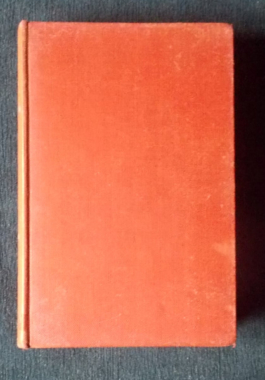
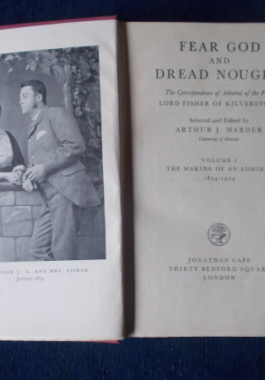 The correspondence of Admiral of the Fleet, Lord Fisher of Kilverstone. Volume I: The Making of an Admiral, 1854 - 1904.
The correspondence of Admiral of the Fleet, Lord Fisher of Kilverstone. Volume I: The Making of an Admiral, 1854 - 1904.



